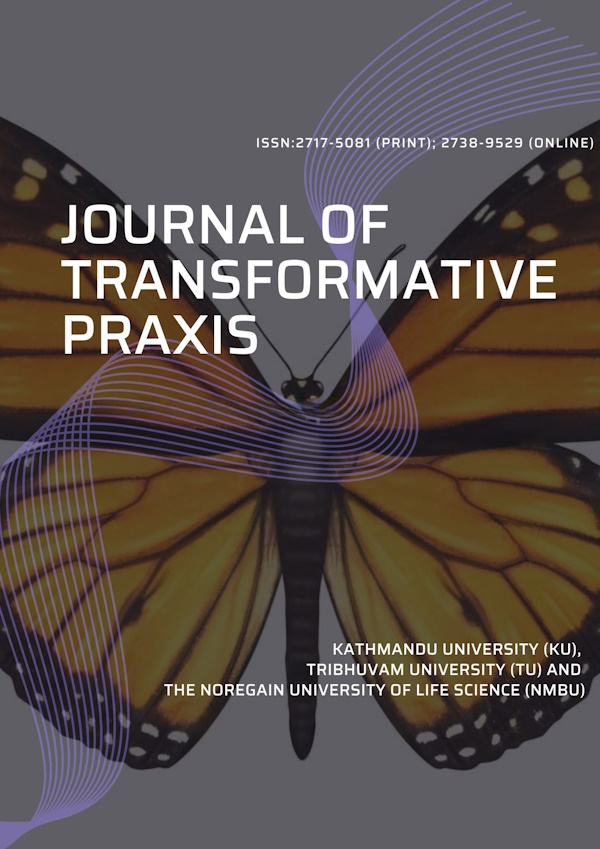
Journal of Transformative Praxis, Volume 5, Issue 1, 2024, 107-111, https://doi.org/10.51474/jrtp/15761
Online publication date: Jul 06, 2024
Publication date: Dec 31, 2024
Views: 2169 | Downloads: 345
Reference: Limbu, S. (2024). What Roles Do Researchers Adopt in Collaborative Research? A Book Review of Collaborative Autoethnography. Journal of Transformative Praxis, 5(1), 107-111. https://doi.org/10.51474/jrtp/15761
Reference: Limbu S. What Roles Do Researchers Adopt in Collaborative Research? A Book Review of Collaborative Autoethnography. Journal of Transformative Praxis. 2024;5(1):107-11. https://doi.org/10.51474/jrtp/15761
Reference: Limbu S. What Roles Do Researchers Adopt in Collaborative Research? A Book Review of Collaborative Autoethnography. Journal of Transformative Praxis. 2024;5(1), 107-111. https://doi.org/10.51474/jrtp/15761
Reference: Limbu, Sudarsan. "What Roles Do Researchers Adopt in Collaborative Research? A Book Review of Collaborative Autoethnography". Journal of Transformative Praxis 2024 5 no. 1 (2024): 107-111. https://doi.org/10.51474/jrtp/15761
Reference: Limbu, S. (2024). What Roles Do Researchers Adopt in Collaborative Research? A Book Review of Collaborative Autoethnography. Journal of Transformative Praxis, 5(1), pp. 107-111. https://doi.org/10.51474/jrtp/15761
Reference: Limbu, Sudarsan "What Roles Do Researchers Adopt in Collaborative Research? A Book Review of Collaborative Autoethnography". Journal of Transformative Praxis, vol. 5, no. 1, 2024, pp. 107-111. https://doi.org/10.51474/jrtp/15761
- Aijazi, O., Amburgey, E., Limbu, B., Suji, M., Binks, J., Balaz-Munn, C., Rankin, K., & Shneiderman, S. (2021). The ethnography of collaboration: Navigating power relationships in joint research. Collaborative Anthropologies 13(2), 56-99. https://doi.org/10.1353/cla.2021.0003
- Dahal, N. (2023). Is doing research for people or on people? A book review of Emancipatory and Participatory Research for Emerging Educational Researchers: Theory and Case Studies of Research in Disabled Communities. The Qualitative Report, 28(1), 69-74. https://doi.org/10.46743/2160-3715/2023.6136
- Dahal, N. (2024). How do we craft autoethnography? A modest review. The Qualitative Report, 29(4), 1030-1037. https://doi.org/10.46743/2160-3715/2024.7218
- Dahal, N., & Luitel, B. (2022). Understanding and encountering the ethics of self and others in autoethnography: Challenging the extant and exploring possibilities. The Qualitative Report, 27(12), 2671-2685. https://doi.org/10.46743/2160-3715/2022.5572
- Dahal, N., & Luitel, B. C. (2023). Collaborative autoethnography: Emancipatory research for educational researchers. Journal of Transformative Praxis, 4(1), 1-8. https://doi.org/10.51474/jrtp.v4i1.659
- Hornsby, E. & Davis, A. & Reilly, J. (2021). Collaborative autoethnography: Best practices for developing group projects. In Sight: A Journal of Scholarly Teaching, 16, 104-114. https://doi.org/10.46504/16202105ro
- Luitel, B. C., & Dahal, N. (2021). Autoethnography: Writing lives and telling stories. Journal of Transformative Praxis, 2(1), 1-7. https://doi.org/10.51474/jrtp.v2i1.530
- Pretorius, L. (2022). A harmony of voices: The value of collaborative autoethnography as collective witnessing during a pandemic. In: Cahusac de Caux, B., Pretorius, L., Macaulay, L. (eds), Research and Teaching in a Pandemic World. Springer. https://doi.org/10.1007/978-981-19-7757-2_3
- Roy, R. & Uekusa, S. (2020). "Collaborative autoethnography: “self-reflection” as a timely alternative research approach during the global pandemic", Qualitative Research Journal, 20(4), 383-392. https://doi.org/10.1108/QRJ-06-2020-0054
- Yoder, P. J. & Jaffee, A.T. (2019). Multiple perspectives: Engaging diverse voices in the social studies classroom. In de Oliveira, L.C., Obenchain, K.M., Kenney, R.H., Oliveira, A.W. (eds) Teaching the Content Areas to English Language Learners in Secondary Schools. English Language Education. Springer, Cham. https://doi.org/10.1007/978-3-030-02245-7_21
- Yoeli, H., Dhital, R., Hermaszewska, S., & Sin, J. (2022). A meta-ethnography of participatory health research and co-production in Nepal. Social Science & Medicine, 301, 114955. https://doi.org/10.1016/j.socscimed.2022.114955
Sincere thanks go out to everyone who helped edit and improve this review. I am thankful to Niroj Dahal, for his invaluable assistance in revising this review. I am indebted to the Kathmandu University School of Education for providing a research-based environment, direction, and ongoing support.
This work is licensed under a Creative Commons Attribution-ShareAlike 4.0 International License.
